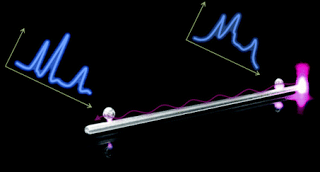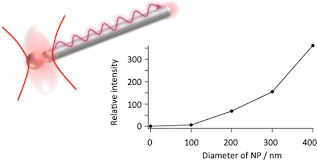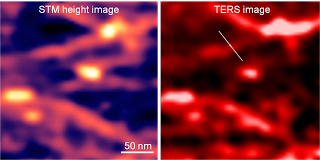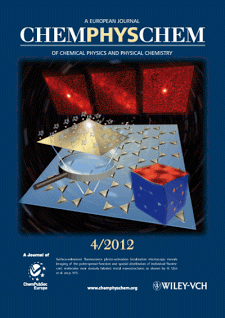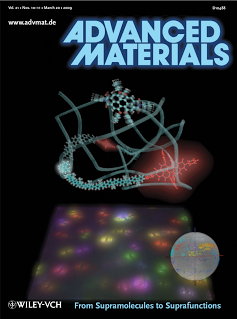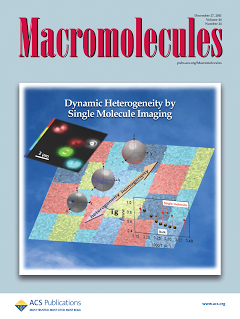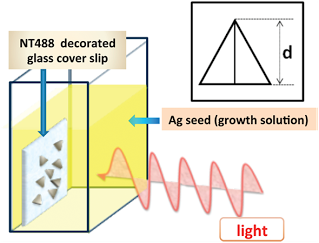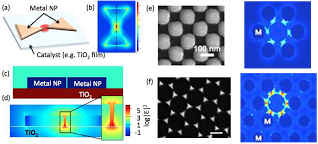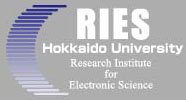
研究内容
|
< 研究内容 >
| 私たちはプラズモニクス研究を応用する可能性・実用性を光化学と光物理学分野の見地から探求しています。 |
|
| Silver nanowires as plasmonic antennas | ||
Uji-i et al demonstrated that by using propagating SPPs along a silver nanowire, Remote Excitation-Surface Enhanced Raman Scattering (RE-SERS) is possible. The coupling position of the incident light has to be precisely controlled; since the diffraction limit of the focused laser is ~300nm and the diameter of the nanowire is ~100nm, it is safe to assume the precision of localization of the laser light has to be 100nm. Kenens et al. showed this by combining scanning optical microscopy (SOCM) with AFM to investigate in- and out-coupling of the light of a focused 632.8 nm laser. To improve the coupling of light into the SPPs on the nanowire, a nanoparticle is attached on the end of the wire. We have showed that a nanoparticles positioned at the end of a nanowire enhances the in-and out-coupling efficiency with a factor 4 (figure 3). |
| Tip-enhanced Raman microscopy | ||
Raman spectroscopy is a powerful analytical technique providing a detailed vibrational fingerprint from the molecules under investigation. However, Raman scattering is relatively weak compared to, e.g., fluorescence.
Surface enhanced Raman scattering (SERS) has helped to overcome this problem, offering signal enhancements of several orders of magnitude over conventional Raman scattering. The (often random) heterogeneity of SERS substrates leads to high variations in electromagnetic field enhancement across the sample surface, which limits the potential range of application. Reducing the enhancing substrate to a single local 'hot spot' at the end of a very sharp tip, which can be accurately positioned on the sample surface (e.g. by using a scanning probe microscope) circumvents this issue and is called Tip-Enhanced Raman Scattering (TERS) microscopy. |
||
| 2. Single Molecule Studies - 単一分子研究 |
| A major challenge for present research lies in the unraveling and understanding of the nanometer-scale structuring and ordering of complex molecules and materials. One technique that has shown strong promise in this regard is single-molecule fluorescence spectroscopy (SMFS). With this technique, an individual molecule can be used as a nanometer-sized probe, where its emission dynamics report on its nanoscale surroundings. |
| Super resolution microscopy on metal nanostructures | ||
|
| Defocused wide-field imaging | ||||
Developing molecular systems with functions analogous to those of macroscopic machine components, such as rotors, gyroscopes and valves, is a long-standing goal of nanotechnology. However, macroscopic analogies go only so far in predicting function in nanoscale environments, where friction dominates over inertia. Here, we visualize the motions of surface-bound molecular rotors using defocused fluorescence imaging, and observe the transition from hindered to free Brownian rotation by tuning medium viscosity.
|
| 3. Plasmon Associated Energy Harvesting - 環境発電に関わるプラズモン | ||
| Light induced synthesis | ||
The successful application of nanoparticles (NPs) in optoelectronic and other nanoscale devices imposes stringent conditions on the NPs, for example, monodispersity both in size and shape, stability in ambient conditions, a crystalline morphology with well-defined edges and smooth surface, and so on.
|
| Plasmon-enhanced photocatalysis | ||
A transition from the classical thermally driven processes to photo-stimulated reactions can contribute to the development of sustainable chemistry. In this transition, photocatalytic materials could play a major role. So far, UV responsive materials like titania- and zincoxide have shown catalytic activity in, mostly, oxidation reactions. However, to further extend the uses of these materials in sustainable chemistry, an optical response in the visible light and therefore the possible use of solar light-energy, is necessary.
For the plasmon-enhanced electric field to have a significant effect on the catalysts performance, the catalysts have to be located inside that field. To achieve the localization of the catalyst, we use two approaches. In the first approach, a plasmonic nanostructure is placed parallel to a catalytic surface. In this case, it is important that the nanostructure is flat so the enhanced electric field can penetrate into the catalyst surface. In the second approach, the catalyst is coated onto the building blocks of the plasmonic nanostructures, the noble metal nanoparticles (NPs), followed by an assembly into the desired structure. In this way, the enhanced electric field created between two (or more) NPs will always penetrate a part of the catalyst. |
| 4. Drug Delivery System Based on Plasmonics - プラズモニクスを基とする薬輸送システム | ||
| Plasmon-enhanced singlet oxygen generation | ||
Photodynamic therapy (PDT) is a promising technique for the treatment of cancer and Singlet oxygen is known to be the responsible cytotoxic agent of this therapy. Singlet oxygen is an excited state of molecular oxygen and can react with surrounding biomolecules in a cell, leading to cell death by apoptosis or necrosis(1).
Due to plasmonic interaction, photophysical properties of the photo-sensitizer are modified, resulted in change in efficiency of single-oxygen generation (4) (5) (Fig.3). |
| Plasmon-heating triggered drug delivery |
| The leakage problem in drug delivery system (DDS) is vital since it may introduce serious side effect, thus it is important and urgent to develop a “zero leakage" DDS. In our research, by introducing plasmonic structure, the drug release from DDS can be triggered by plasmon-heating, making "zero leaking" practically possible in DDSs. |
